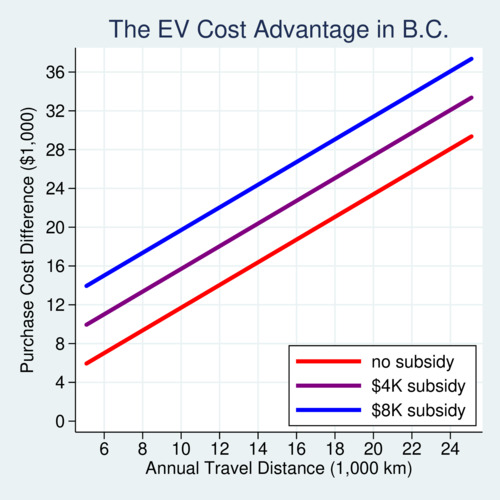Today I was guest on Michelle Eliot's BC Today program on CBC Radio 1. The topic was electric vehicles (EVs), as the federal government will mandate that all new car purchases are zero emission vehicles (ZEVs) by 2035 (see announcement). One of the questions that came up was: are EVs affordable? As I mentioned in my April 21 blog, EV adoption in BC is rising rapidly. More and more drivers are realizing that EVs are a smart economic choice.
‘Cost comparisons for EVs need to be based on total lifetime cost.’
It is true that electric vehicles are still significantly more expensive to buy than equivalent gasoline-powered models, but this does not mean they are more expensive overall when total lifetime costs are taken into account. Lifetime costs consist of upfront purchase cost, annual maintenance cost, and variable cost from fuel purchases. It is the lifetime cost that matters ultimately, but many potential EV buyers suffer "sticker shock" when they only focus on the purchase price.
The full lifetime ownership cost is already tilting in favour of EVs, at least in British Columbia. To quantify the fuel cost advantage, compare a typical EV with a typical gas-powered car. The gas-powered car consumes about 9 liters per 100km, while the EV consumes about 24 kilowatt-hours (kWh) per 100km. Assume a fuel price of $1.70 per litre (as it will also go up over time due to carbon tax increases) and an electricity price of $0.15 per kWh. Further assume a vehicle life time of 10 years; the average lifetime of a vehicle is slightly longer, but by shortening it I allow for some implicit present-value discounting. The graph below shows the cost difference that emerges based on annual driving volume. The average car is driven about 12,000 km per year, but some people drive substantially more. The more a car is driven, the larger the savings from using electricity rather than gasoline. The horizontal axis on the chart shows annual driving volume between 5,000 and 25,000 kilometers.
The federal and provincial governments currently offer generous EV purchase incentives. Qualifying battery-electric vehicles (BEVs) can receive $5,000 from the federal government if the battery has at least 15 kWh capacity, and $3,000 from the provincial government of BC if the battery has a range greater than 85 km. Plug-in hybrid-electric vehicles (PHEVs) can receive $2,500 and $1,500, respectively. In the diagram below the purple and blue lines show the additional benefit of receiving either $4,000 or $8,000 in subsidies. The red line shows the case without subsidy, which applies to EVs with a base cost of more than $45,000. Luxury cars do not qualify for EV subsidies.

click on image for high-resolution PDF version
‘With today's generous EV subsidies, driving electric can be a smart economic choice.’
Let's look at a concrete example. A popular BEV is the Hyundai Kona Electric. The mid-range BEV retails for about $47K before taxes and qualifies for $8K in subsidies. Total purchase price is $44.5K when the rebate is included. The gas-powered mid-range version of the Hyundai Kona sells for about $28.0K. The EV is thus still $16.5K more expensive than the gas-powered version. Yet, the fuel cost savings are substantial and can offset the higher purchase price. It just matters how much the vehicle is driven per year. If the owner of the vehicle drives more than 16,000 kilometers per year, the higher EV purchase cost fully amortizes. This does not take into account that EVs tend to have lower maintenance cost per year because EVs have less wear and tear. Electric motors are simpler than gasoline engines.
The bottom line is: EVs are already cost-competitive for many motorists, and as the price of batteries continues to decline, EVs not only reach lifetime cost parity but also will see significantly lower purchase prices. Today, EV incentives still matter, but as more car makers scale up EV production, the need for incentives will diminish rapidly. For luxury vehicles, the EV price premium matters significantly less for affluent buyers, and this is the reason why early adoption of EVs is dominated by more expensive vehicle makes. This picture will change rapidly in the next years.
The remaining problems are about EV charging infrastructure, clean power supply, and responsible mining of upstream minerals and metals. I will return to these important questions in future blogs.
![[Sauder School of Business]](logo-ubc-sauder-2016.png)
![[The University of British Columbia]](logo-ubc-2016.png)